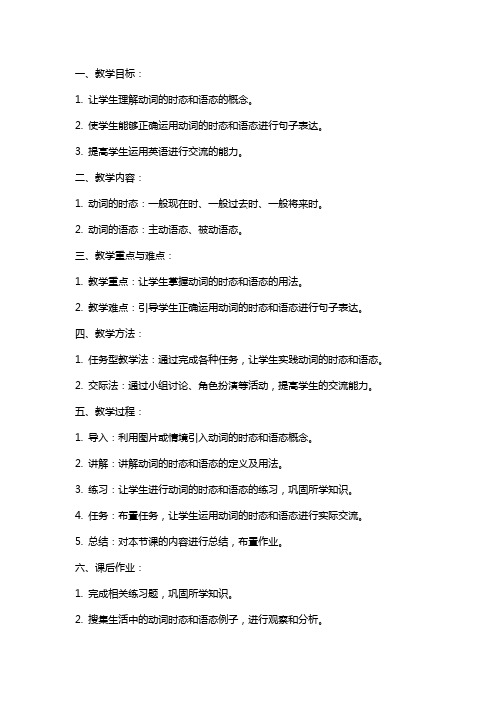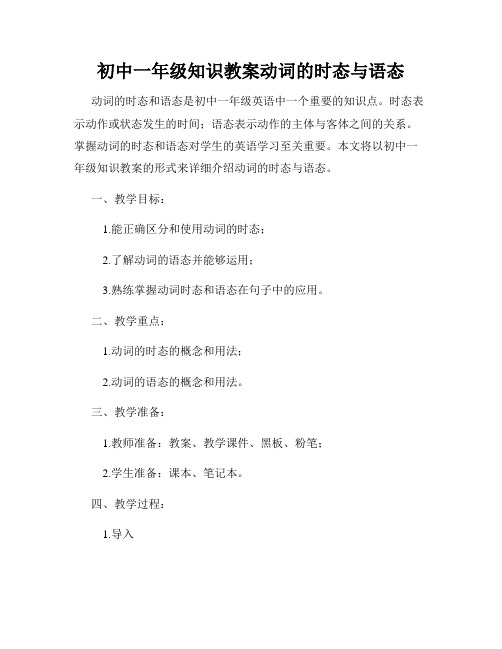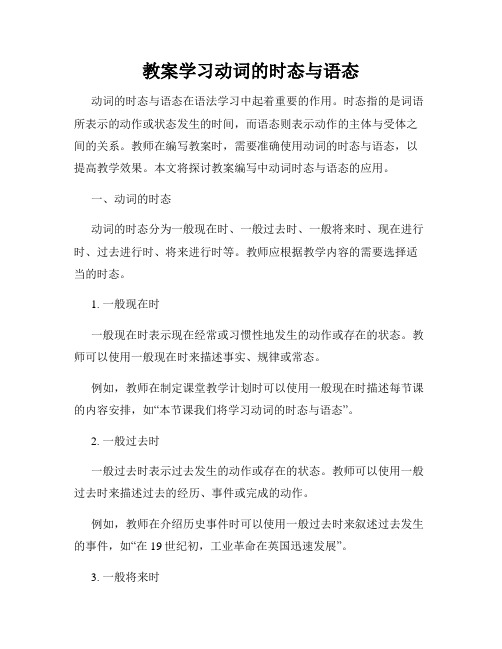动词的时态和语态学案
动词的时态和语态教案

一、教学目标:1. 让学生理解动词的时态和语态的概念。
2. 使学生能够正确运用动词的时态和语态进行句子表达。
3. 提高学生运用英语进行交流的能力。
二、教学内容:1. 动词的时态:一般现在时、一般过去时、一般将来时。
2. 动词的语态:主动语态、被动语态。
三、教学重点与难点:1. 教学重点:让学生掌握动词的时态和语态的用法。
2. 教学难点:引导学生正确运用动词的时态和语态进行句子表达。
四、教学方法:1. 任务型教学法:通过完成各种任务,让学生实践动词的时态和语态。
2. 交际法:通过小组讨论、角色扮演等活动,提高学生的交流能力。
五、教学过程:1. 导入:利用图片或情境引入动词的时态和语态概念。
2. 讲解:讲解动词的时态和语态的定义及用法。
3. 练习:让学生进行动词的时态和语态的练习,巩固所学知识。
4. 任务:布置任务,让学生运用动词的时态和语态进行实际交流。
5. 总结:对本节课的内容进行总结,布置作业。
六、课后作业:1. 完成相关练习题,巩固所学知识。
2. 搜集生活中的动词时态和语态例子,进行观察和分析。
七、评价方式:1. 课堂表现:参与度、回答问题准确性等。
2. 练习完成情况:作业、练习题的正确性。
3. 任务完成情况:小组活动、角色扮演的表现。
八、教学拓展:1. 对比分析不同动词时态和语态的用法。
2. 引导学生运用动词的时态和语态创作小故事或对话。
九、教学反思:1. 总结本节课的优点和不足。
2. 根据学生的反馈调整教学方法和策略。
十、课程资源:1. 教材:英语课本、辅导书等。
2. 网络资源:相关教学视频、课件、练习题等。
六、教学评价:1. 课堂参与度:观察学生在课堂上的活跃程度和参与度,包括提问、回答问题、小组讨论等。
2. 知识掌握情况:通过课堂练习和课后作业,评估学生对动词时态和语态的理解和运用能力。
3. 交流能力:评估学生在小组活动和角色扮演中运用英语进行交流的能力。
七、教学拓展:1. 对比分析:让学生对比分析不同动词时态和语态在实际语境中的运用差异。
初中一年级知识教案动词的时态与语态

初中一年级知识教案动词的时态与语态动词的时态和语态是初中一年级英语中一个重要的知识点。
时态表示动作或状态发生的时间;语态表示动作的主体与客体之间的关系。
掌握动词的时态和语态对学生的英语学习至关重要。
本文将以初中一年级知识教案的形式来详细介绍动词的时态与语态。
一、教学目标:1.能正确区分和使用动词的时态;2.了解动词的语态并能够运用;3.熟练掌握动词时态和语态在句子中的应用。
二、教学重点:1.动词的时态的概念和用法;2.动词的语态的概念和用法。
三、教学准备:1.教师准备:教案、教学课件、黑板、粉笔;2.学生准备:课本、笔记本。
四、教学过程:1.导入引导学生回忆现在进行时的用法,并通过提问引入到本节课的主题。
2.学习时态1)呈现通过课件和黑板,给学生展示不同的时态表达方式,并提供相应的例句。
2)讲解分别讲解一般现在时、一般过去时和一般将来时的构成和用法,并给予学生足够的例句进行理解和记忆。
3)练习请学生根据提供的句子构造正确的时态形式,并进行小组讨论和答题。
3.学习语态1)呈现展示被动语态的构成和用法,并给予学生例句进行理解。
2)讲解详细讲解被动语态的构成规则和主动语态与被动语态之间的转换。
3)练习提供一些句子,要求学生将其改写为被动语态,并进行小组互动讨论。
4.巩固与拓展1)练习时态和语态的综合运用提供一些综合性的练习题,要求学生根据上述学习内容完成句子的时态和语态转换。
2)拓展思考引导学生思考更多复杂的时态和语态转换,并提供一些拓展性的题目进行讨论和解答。
五、课堂小结:通过本节课的学习,学生们对动词的时态和语态有了更深入的了解,并能够运用掌握的知识进行时态和语态的转换。
六、课后作业:1.完成课本上相关的习题;2.总结本节课学到的知识,写一篇小结。
七、教学反思:本节课教学设计合理,通过引入知识点、讲解、练习和巩固拓展等环节,提高了学生对动词时态和语态的掌握。
如果有更多时间,可以增加一些拓展性的活动,如小组辩论、情景模拟等,以增加学生的实际运用能力。
人教版小学英语四年级下册 《动词的时态和语态》教案

人教版小学英语四年级下册《动词的时态和语态》教案一、教学目标1.掌握动词的时态和语态的基本概念;2.能够正确使用一般现在时、一般过去时和将来时;3.能够理解和使用主动语态和被动语态。
二、教学内容1.动词的时态:一般现在时(Simple Present ___)一般过去时(Simple Past ___)将来时(Future ___)2.动词的语态:主动语态(Active Voice)被动语态(Passive Voice)三、教学步骤步骤一:导入新知1.引导学生回顾一般现在时的用法和句子结构,并与其它时态进行比较。
步骤二:学习时态1.介绍一般过去时和将来时的用法,并让学生观察和分析相应的句子例子。
2.组织学生进行练习,巩固并加深对时态的理解和应用。
步骤三:学习语态1.引导学生理解主动语态和被动语态的概念并进行比较。
2.讲解被动语态的结构和使用,并通过例句进行讲解。
3.练习使用被动语态,培养学生灵活运用语态的能力。
步骤四:巩固综合练习1.组织学生进行综合练习,巩固所学的动词时态和语态。
可以采用填空、对话、句子改写等形式。
步骤五:作业布置1.布置适当的作业,要求学生用所学的动词时态和语态完成相应的练习题。
2.鼓励学生自主学习,复习并巩固所学的内容。
四、教学评估1.教师根据学生在课堂上的表现,对其掌握程度进行评估。
2.学生完成作业后,教师进行作业评价和反馈。
五、教学延伸1.鼓励学生扩展自己的词汇量和语法知识,提高英语应用能力。
2.引导学生运用所学的动词时态和语态进行口语和写作练习,提高语言表达能力。
以上是《动词的时态和语态》的教案内容,通过系统的教学安排和练习,能够帮助学生更好地理解和运用动词的时态和语态。
注意:以上内容供参考,具体教学内容和步骤可以根据实际情况进行调整和优化。
动词时态和语态的教案-经典教学教辅文档

动词时态和语态教案专题要点:动词时态和语态要点概述如下:普通如今时表示习气性、个人能力、普遍真理;表示“曾经列入日程表”经常用普通如今时表示将来;2、表示说话人始料的事,常用普经过去时;3、工夫状语从句或条件状语从句中常用普通时表将来;4、 Will/be going to do/be about to do的用法区别;5、用自动方式表示被动意义常见的几种情况;考纲要求:时态与语态不断是热点,也是广大考生复习备考的难点,考纲要求考生该当具备较强的言语运用能力,能在具体语境中恰当、精确地运用某一特定时态;同时还要纯熟运用特殊时态句式和用法和不用被动式但表示被动的动词和短语。
◆动词时态的核心考点1.普通如今时考点分析(1)表示客观现实或普遍真理(不受时态限制)。
Time and tide wait for no man.(2)表示现状、性质、形状时多用系动词或形状动词;表示经常或习气性的动作,多用动作动词,且常与表频率的工夫状语连用。
They always care for each other and help each other.(3)表示知觉、态度、感情、某种抽象的关系或概念的词常用普通如今时:see,hear,smell,taste, feel, notice, agree, believe, like, hate, want, think, belong to, seem 等。
Smith owns a car and a house.All the students here belong to No.1 Middle School(4)在工夫、条件状语从句中常用普通如今时期替将来时。
但要留意由if引导的条件状语从句中可以用shal或will表“志愿”,但不表示时态。
If you will accept my invitation and come to our party, my family will be pleased。
教案学习动词的时态与语态

教案学习动词的时态与语态动词的时态与语态在语法学习中起着重要的作用。
时态指的是词语所表示的动作或状态发生的时间,而语态则表示动作的主体与受体之间的关系。
教师在编写教案时,需要准确使用动词的时态与语态,以提高教学效果。
本文将探讨教案编写中动词时态与语态的应用。
一、动词的时态动词的时态分为一般现在时、一般过去时、一般将来时、现在进行时、过去进行时、将来进行时等。
教师应根据教学内容的需要选择适当的时态。
1. 一般现在时一般现在时表示现在经常或习惯性地发生的动作或存在的状态。
教师可以使用一般现在时来描述事实、规律或常态。
例如,教师在制定课堂教学计划时可以使用一般现在时描述每节课的内容安排,如“本节课我们将学习动词的时态与语态”。
2. 一般过去时一般过去时表示过去发生的动作或存在的状态。
教师可以使用一般过去时来描述过去的经历、事件或完成的动作。
例如,教师在介绍历史事件时可以使用一般过去时来叙述过去发生的事件,如“在19世纪初,工业革命在英国迅速发展”。
3. 一般将来时一般将来时表示将来将要发生的动作或存在的状态。
教师可以使用一般将来时来表达将来的计划、安排或预测。
例如,教师在说明下一次课堂活动时可以使用一般将来时,如“下节课我们将进行小组讨论”。
4. 现在进行时现在进行时表示现在正在进行的动作。
教师可以使用现在进行时来描述目前正在进行的活动或临时的决定。
例如,教师在课堂上组织学生进行小组活动时可以使用现在进行时,如“现在我们正在讨论这个问题”。
5. 过去进行时过去进行时表示过去某个时间正在进行的动作。
教师可以使用过去进行时来描述过去的同时进行的活动。
例如,教师在复习过去的一个事件时可以使用过去进行时,如“昨天下午我正在教室里给学生上课”。
6. 将来进行时将来进行时表示将来某个时间正在进行的动作。
教师可以使用将来进行时来描述未来某个时间的同时进行的活动。
例如,教师在说明下一节课的教学安排时可以使用将来进行时,如“下周我们将进行一次实地考察”。
动词的时态讲义及教案

动词的时态最新讲义及教案第一章:引言1.1 教学目标了解动词时态的概念和重要性掌握动词的基本时态及其用法1.2 教学内容动词时态的定义和分类一般现在时、一般过去时、一般将来时的用法1.3 教学方法讲解法:讲解动词时态的概念和用法互动法:引导学生参与课堂活动,巩固所学知识第二章:一般现在时2.1 教学目标掌握一般现在时的构成和用法能够正确运用一般现在时描述习惯、状态和普遍真理2.2 教学内容一般现在时的构成:主语+动词原形一般现在时的用法:描述习惯、状态、普遍真理等2.3 教学方法讲解法:讲解一般现在时的构成和用法练习法:设计相关练习题,巩固一般现在时的运用第三章:一般过去时3.1 教学目标掌握一般过去时的构成和用法能够正确运用一般过去时描述过去的事情和动作3.2 教学内容一般过去时的构成:主语+动词过去式一般过去时的用法:描述过去的事情和动作3.3 教学方法讲解法:讲解一般过去时的构成和用法练习法:设计相关练习题,巩固一般过去时的运用第四章:一般将来时4.1 教学目标掌握一般将来时的构成和用法能够正确运用一般将来时描述将来的动作和计划4.2 教学内容一般将来时的构成:主语+will+动词原形一般将来时的用法:描述将来的动作和计划4.3 教学方法讲解法:讲解一般将来时的构成和用法练习法:设计相关练习题,巩固一般将来时的运用第五章:动词时态的混合运用5.1 教学目标掌握不同动词时态的混合运用能够正确运用动词时态描述复杂的时间顺序和情境5.2 教学内容动词时态的混合运用:一般现在时、一般过去时、一般将来时的组合不同情境下的动词时态选择:描述过去的事情、将来的计划和现在的状态等5.3 教学方法讲解法:讲解动词时态的混合运用和情境选择练习法:设计相关练习题,巩固动词时态的混合运用第六章:现在进行时6.1 教学目标掌握现在进行时的构成和用法能够正确运用现在进行时描述正在进行的动作或状态6.2 教学内容现在进行时的构成:主语+be动词(am/is/are)+动词ing形式现在进行时的用法:描述正在进行的动作或当前的状态6.3 教学方法讲解法:讲解现在进行时的构成和用法情境模拟法:创设情境,让学生实际运用现在进行时进行交流第七章:过去进行时7.1 教学目标掌握过去进行时的构成和用法能够正确运用过去进行时描述过去某一时刻正在进行的动作7.2 教学内容过去进行时的构成:主语+was/were+动词ing形式过去进行时的用法:描述过去某一时刻正在进行的动作7.3 教学方法讲解法:讲解过去进行时的构成和用法情境故事法:通过故事情境,让学生练习过去进行时的运用第八章:将来进行时8.1 教学目标掌握将来进行时的构成和用法能够正确运用将来进行时描述将来某段时间内正在进行的动作8.2 教学内容将来进行时的构成:主语+will be+动词ing形式将来进行时的用法:描述将来某段时间内正在进行的动作8.3 教学方法讲解法:讲解将来进行时的构成和用法计划编排法:让学生制定将来的计划,并用将来进行时描述第九章:现在完成时9.1 教学目标掌握现在完成时的构成和用法能够正确运用现在完成时描述过去发生的、对现在有影响的动作9.2 教学内容现在完成时的构成:主语+have/has+过去分词现在完成时的用法:描述过去发生的、对现在有影响的动作9.3 教学方法讲解法:讲解现在完成时的构成和用法时间线索法:通过提供时间线索,让学生练习现在完成时的运用第十章:过去完成时10.1 教学目标掌握过去完成时的构成和用法能够正确运用过去完成时描述在过去某一时间点之前已经完成的动作10.2 教学内容过去完成时的构成:主语+had+过去分词过去完成时的用法:描述在过去某一时间点之前已经完成的动作10.3 教学方法讲解法:讲解过去完成时的构成和用法故事情境法:通过故事情境,让学生练习过去完成时的运用第十一章:将来完成时11.1 教学目标掌握将来完成时的构成和用法能够正确运用将来完成时描述在将来某一时间点之前已经完成的动作11.2 教学内容将来完成时的构成:主语+will have+过去分词将来完成时的用法:描述在将来某一时间点之前已经完成的动作11.3 教学方法讲解法:讲解将来完成时的构成和用法情境设定法:设定未来的情境,让学生练习将来完成时的运用第十二章:被动语态12.1 教学目标掌握被动语态的构成和用法能够正确运用被动语态描述动作的承受者12.2 教学内容被动语态的构成:be动词(am/is/are)+过去分词被动语态的用法:描述动作的承受者12.3 教学方法讲解法:讲解被动语态的构成和用法角色扮演法:让学生通过角色扮演,实际运用被动语态进行交流第十三章:动词不定式13.1 教学目标掌握动词不定式的构成和用法能够正确运用动词不定式作主语、宾语、表语等13.2 教学内容动词不定式的构成:to+动词原形动词不定式的用法:作主语、宾语、表语等13.3 教学方法讲解法:讲解动词不定式的构成和用法练习法:设计相关练习题,巩固动词不定式的运用第十四章:动词短语14.1 教学目标掌握动词短语的构成和用法能够正确运用动词短语表达特定的动作或状态14.2 教学内容动词短语的构成:动词+副词/介词/名词等动词短语的用法:表达特定的动作或状态14.3 教学方法讲解法:讲解动词短语的构成和用法情境创设法:创设情境,让学生实际运用动词短语进行交流第十五章:综合练习与拓展15.1 教学目标巩固所学的动词时态和语态知识提高学生在实际语境中运用英语的能力15.2 教学内容设计综合练习题,涵盖动词时态和语态的各种用法提供实际语境,让学生运用所学知识进行交流15.3 教学方法练习法:让学生通过练习题,巩固所学知识交流法:提供实际语境,促进学生之间的交流和互动重点和难点解析本文主要介绍了英语动词的时态和语态,包括一般现在时、一般过去时、一般将来时、现在进行时、过去进行时、将来进行时、现在完成时、过去完成时、将来完成时、被动语态、动词不定式和动词短语等。
时态语态(学案教案).doc
高三英语时态语态(1)学习目标:能够根据语境正确运用动词的时态、语态。
Examples:(用括号内动词的正确形式填空)1. I _____________(go) to school every day.2. He ______________(go) out just now.3. I _________________(have) eggs and toast for breakfast tomorrow morning.4. When I called him, he __________________ (have) dinner.5. Mary ___________________(see) a film this time tomorrow.6. The rooms ________________________(paint) by some workers now.【课堂任务】一、知识网络▲在表示主动关系时(即主语为动作的执行者时),谓语的形式称为主动语态。
不知道或没有必要说明动作的执行者是谁,或者需要突出或强调动作的承受者时,就用被动语态。
1.一般现在时:表示经常性或习惯性的动作;现在的特征或状态;普遍真理。
Light _____________(travel) faster than sound.2.一般过去时:表示过去某时发生的动作或情况。
Bob would have helped us yesterday, but he __________(be) too busy.Ten computers ____________________(buy) last term.3.一般将来时:表示将要发生的动作或情况。
I __________________(lend) you this book when I finish reading it.The work _____________________(finish) in ten days.4.现在进行时:表示现在或现在这一阶段正在进行的动作。
初中二年级教案动词时态与语态
初中二年级教案动词时态与语态初中二年级教案:动词时态与语态动词时态和语态是英语学习中非常重要的部分,它们对于正确交流和理解英语语句起着关键作用。
在初中二年级,学生们需要逐步掌握动词时态和语态的基本用法,并能够准确运用于口语和写作中。
本教案将介绍动词时态和语态的基本概念,并提供一些有效的教学方法和活动。
通过本教案的学习,学生们将能够更好地理解和运用动词时态和语态。
一、动词时态的概念和用法1. 现在时态:现在时态表示目前正在进行或经常发生的动作、状态或习惯。
常见的现在时态包括:一般现在时、现在进行时和现在习惯性时等。
例如:- 一般现在时:He watches TV every night.- 现在进行时:They are playing basketball in the park.- 现在习惯性时:She usually goes swimming on Saturdays.2. 过去时态:过去时态表示过去某个时间点或一段时间内的动作或状态。
过去时态有简单过去时和过去进行时等。
- 简单过去时:I ate dinner an hour ago.- 过去进行时:They were studying English at this time yesterday.3. 将来时态:将来时态表示将要发生的动作或状态。
将来时态可以用一般将来时、将来进行时等来表达。
例如:- 一般将来时:They will visit their grandparents next week.- 将来进行时:I will be studying when you come.二、动词语态的概念和用法1. 主动语态:主动语态表示主语是动作的执行者。
它在句子中常用的形式是:主语 + 动词 + 宾语。
例如:- 主动语态:She wrote a letter.2. 被动语态:被动语态表示主语是动作的承受者,而不是动作的执行者。
它在句子中常用的形式是:主语 + be动词 + 过去分词 + 介词 + 宾语。
动词的时态和语态教案
动词的时态和语态教案动词的时态和语态⼀.教学⽬标:从宏观⾓度把握动词的时态和语态的⽤法⼆.教学重点,难点:1.动词时态的构成,⽤法及中考考点。
2.被动语态的⽤法3.被动语态的特殊⽤法三.教学辅助⼯具:图画,练习题四.教学步骤:1.Greeting: Say hello to the student.2.Warm-up: Sing an English song about some verbs.3.Revision: The classify of Verb.4.Leading-in: Ask students“when do they get up everyday”and “When do they go to school” in Chinese. Then,Tell them what is Simple Present tense. According to thiskind of way, we can learn the other tenses.5.Teaching content:动词的时态从分类的⾓度⼀般现在时⼀般过去时⼀般将来时现在进⾏时现在完成时过去进⾏时过去完成时过去将来时从中考考点的⾓度⼀般现在时⼀从构成的⾓度:肯定式:主语+ 动词原形+ ….They speak English and French .主语+ 动词三单:She studies in a school near here.否定句:主语+助动词do/does+not+动词原形He doesn’t feel very well.⼀般疑问句: Do/does+主语+动词原形Do you speak English?回答: Yes,主语+do/doesNo,主语+don’t/doesn’t实义动词have当”有”讲时,疑问句有以下变化形式:Have you a penfriend?Do you have a penfriend ?Have you got a penfriend?特殊疑问句:特殊疑问词(where,when,how,why)+do/does+主语+动词原形(不⽤yes,no回答)Where does ZhouNan study?选择疑问句:Do you like this book or that one?⼆从⽤法的⾓度:1.表⽰经常性,习惯性的动作或经常存在的状态,常与always,often,usually,everyday,sometime等连⽤(通常⽤于be后,⾏为动词前)e.g.)Lei Feng is always ready to help other.I am always/usually go to school at 7 o’clock.2.表⽰普遍性的真理与规律The moon goes round the esrth.⽉亮绕着地球转.Light travels faster than sound.3.表⽰习惯与能⼒Do you drive a car? 你会开车吗?Mr Green teaches English.4.表⽰按规定,计划或安排预计要发⽣的动作或存在状态(主要⽤于come,go,leave,begin,start,arrive,return等瞬间动词)Could you tell me what time the plan leaves?Do you know what time the plan arrives in Moscow?5.在时间,条件状语从句中表⽰将来动作When you climb higher, you’ll find nothing grows there at all.Tom won’t feel well till the game is over.6.⼀般现在时表将来表最近的将来,说话⼈说话时动作并未发⽣,但即将开始(I’m off now .)或强调未来的事实和早已规定的事. ( Tomrrow is Sunday.)特殊⽤法⾓度:1.表⽰说话时刻,这⼀刻往往很短暂.What time is it now ?My watch says ten to seven.2.有些表⽰⼼理状态和感情,感觉的动词常⽤于⼀般现在时I feel better now.It doesn’t matter t his time .Does it hurn here?3 ⽤于下列句型中There goes the bell.Why don’t you go by bus?Why don’t/they/we +动词原形Why doesn’t he +动词原形Why not have a drink of tea?Here comes Jim..⼀般过去时⼀.从构成的⾓度:肯定式:主语+动词的过去式I wanted to watch animals in the zoo.They took his son to the cinema.否定式:主语+didn’t+动词原形I didn’t have his telephone number.⼀般疑问句:特殊疑问词+did+主语What sport did she play yesterday?⼀般过去时没有⼈称及数的变化⼆.从基本⽤法的⾓度:1.表⽰过去某时发⽣的动作或存在的状态.(常与其连⽤的时间状语有:yesterday ,the day before yesterday ,a moment ago ,just now ,in May, in 1999,lastnight/week/month/year ,once ,one day ,before… at the age of 18,when she was five…等)e.g.)He was a soldier two years ago.They had a baby last month.2.表⽰过去经常或反复发⽣的动作或⾏为(never ,often ,always)e.g.)They didn’t pass the ball often enough.He always took off his shoes and threw on the floor.3.根据时态⼀致,在宾语从句中⽤⼀般过去时代替⼀般现在时e.g.)She asked weather they needed some more tea.(瞬问的动作是过去,”需要”指现在)He said that there wasn’t time to go to the city century.过去了现在4.⽤于since从句,(主句的谓语动词为现在完成时,其后since从句为⼀般过去式)He has worked there since it opened in 1989.It has been two days since I came back.5.由于when,while,before,after,whenever等引导的表⽰过去时间的状语从句常⽤过去时.e.g.)The boy began to go to school when he was five.They lived there before they came to China.6.有些情况和事件,发⽣的时间不很清楚,但实际已发⽣,应当⽤过去时态.Look at the bags.They came.Five people died in the traffic accident.特殊⽤法的⾓度1.在时间,条件状语从句中表⽰过去将来的动作.If we won the match,we would be top.2.⼀般过去时形式上为过去时,实指现在I didn’t know you were th ere.(刚才不知,现在知道了.)⼀般将来时⼀:从构成的⾓度:肯定形式:主语+will+动词原形/主语+ Am/is /are +going to 动词原形否定形式:都是在will/am/is /are这些助动词后加not即可。
教案学习动词的时态与语态
教案学习动词的时态与语态时态与语态在英语学习中是非常重要的内容,掌握好时态与语态的使用可以帮助学生在写作和口语表达上更加流利自如。
本文将就教案学习动词的时态与语态进行详细探讨。
一、时态的基本概念时态主要指表示动作或状态发生的时间。
英语中常见的时态有现在时、过去时、将来时、完成时等。
1. 现在时现在时用来表示目前正在进行的动作或者普遍的真理、客观事实等。
现在时的基本形式有三种:一般现在时、进行现在时和现在完成时。
(1)一般现在时一般现在时表示经常发生的动作或客观事实,它的结构为"主语 +动词原形"。
例句:- I brush my teeth every morning.(我每天早上刷牙。
)- Water boils at 100 degrees Celsius.(水在100摄氏度沸腾。
)(2)进行现在时进行现在时表示现阶段正在进行的动作,它的结构为"主语 + be动词 + 现在分词"。
例句:- They are watching TV in the living room.(他们正在客厅看电视。
)- I am reading a book right now.(我正在看书。
)(3)现在完成时现在完成时表示过去发生的某个动作对现在产生的影响,它的结构为"主语 + have/has + 过去分词"。
例句:- I have finished my homework.(我已经完成作业了。
)- They have lived here for five years.(他们住在这里已经五年了。
)2. 过去时过去时用来表示过去某个时间发生的动作或者状态,它的基本形式有三种:一般过去时、进行过去时和过去完成时。
(1)一般过去时一般过去时表示过去某个时间发生的动作或状态,它的结构为"主语 + 动词过去式"。
例句:- She called me last night.(她昨晚给我打电话了。
- 1、下载文档前请自行甄别文档内容的完整性,平台不提供额外的编辑、内容补充、找答案等附加服务。
- 2、"仅部分预览"的文档,不可在线预览部分如存在完整性等问题,可反馈申请退款(可完整预览的文档不适用该条件!)。
- 3、如文档侵犯您的权益,请联系客服反馈,我们会尽快为您处理(人工客服工作时间:9:00-18:30)。
动词的时态和语态学案一、用所给单词的适当形式填空1. I think high school students should__________ (give) pocket money2.The earth ________ (go) around the sun.3.Black tea____________(invent) in China more than 600 years ago4.There ________ (be) more than 50 schools in our city next year.5.Parking ____________ (not allow) here.6.I __________ (have) this bike for more than two years.动词的时态时态用法构成时间状语例句一般过去时表示过去曾经发生的动作或存在的状态。
动词的过去式yesterday,lastnight/Monday/week/month/year,in 2010,threemonthsago, just now等。
When I was achild, IoftenPlayedfootball in thestreet.当我还是个孩子时,我经常在街上踢足球。
一般将来时表示将来发生的动作或存在的状态。
shall/will+动词原形;begoing to+动词原形tomorrow,next year, intwo years,fromnow on,in thefuture等。
They aregoing to haveasportsmeetingin a week.他们一周后要举行一场运动会。
现在进行时表示说话时或现阶段正在进行或发生的动作。
is/am/are+动词的现在分词(v.-ing)now, at themoment, atpresent,thesedays等。
We arehavingan Englishclass now.我们现在正在上英语课。
过去进行时表示过去某个时刻或某一阶段正在进行或发生的动作。
was/were+动词的现在分词At this timeyesterday, at 9last night,from 7to 9yesterdaymorningTheyWerewatchingTV at 7 lastnight.昨晚7 点他们正在看电视。
注意:come, go, leave, arrive 等表示位置移动的动词可用现在进行时表示即将发生的或计划好的事情。
如:I'm leaving tomorrow.我明天动身。
动词的第三人称单数1.一般情况直接加-s。
如:stop—stops look—looks read—reads2.以s, x, ch, sh, o 结尾的动词加-es。
如miss—misses do—does watch—watches wash—washes fix—fixes3.以辅音字母加y 结尾的动词,变y 为i 再加-es。
如:hurry—hurries cry—cries carry—carries4.be 动词的三种形式:am, is, are5.特殊:have—has动词的过去式和过去分词1.规则动词:(1)一般情况直接加-ed。
如:rain—rained clean—cleaned watch—watched(2)以不发音字母e 结尾的动词,只加-d。
如:live—lived like—liked move—moved(3)以一个辅音字母结尾的重读闭音节动词,双写该辅音字母,再加-ed。
如:drop—dropped stop—stopped plan—planned(4)以辅音字母加y 结尾的动词,应变y 为i 再加-ed。
如:carry—carried study—studied cry—cried2.不规则动词:不规则动词过去式和过去分词的变化规律性不强,只能分别记忆。
动词的现在分词1.一般情况在词尾加-ing。
如listen—listening do—doing study—studying2.以不发音字母e 结尾的动词,去e 加-ing。
如:have—having make—making3.以一个辅音字母结尾的重读闭音节动词,双写该辅音字母,再加-ing。
如:run—running get—getting begin—beginning4.以字母ie 结尾的动词,变ie 为y 再加-ing。
如:die—dying lie—lying现在完成时中的一些重要用法1.短暂性动词和延续性动词短暂性动词可用于完成时态,说明某个动作的结果还存在,但不能与表示一段时间的时间状语连用,也不能用于how long引导的特殊疑问句中。
如需使用,此时要将短暂性动词转换为延续性动词。
如:borrow—keep die—be deadbuy—have join—be a member of/be inbegin/start—be onfinish/end—be overcome/go/arrive—be in/atleave—be away (from)become—beopen—be openclose—be closedsleep—be asleepmarry—be marriedreturn—be backget up—be up2.have/has gone to, have/has been to 和have/has been in 的区别(1)have/has gone to 强调“在去某地的路上或在某地”,人还未回来。
如:Has he gone to Qingdao?他去青岛了吗?(2)have/has been to 强调“去过某地”,人已经回来了。
如:Have you been to our town before?你以前曾经去过我们镇吗?(3)have/has been in 强调“一直待在某地”,常与一段时间连用。
如:He has been in Guangzhou since 1989他自从1989 年就待在广州了。
3.现在完成时和一般过去时的区别(1)现在完成时强调过去动作产生的结果对现在的影响,与现在有关;一般过去时仅强调在过去某一时刻曾经发生的动作,与现在无关。
如:He has studied English for five years.他学英语五年了。
(说明他现在还在学)He studied English for five years.他曾学过五年英语。
(只说明他过去学过五年英语,但现在学不学就不知道了)(2)一般过去时常与具体的时间状语连用,而现在完成时常与模糊的时间状语连用,或无时间状语。
被动语态动词有两种语态:主动语态和被动语态。
主动语态表示主语是谓语动作的执行者;被动语态则表示主语是谓语动作的承受者。
中考考纲只要求考生掌握一般现在时、一般过去时、一般将来时及含有情态动词的被动语态。
被动语态的构成1.一般现在时的被动语态肯定句:主语+am/is/are+过去分词+其他否定句:主语+am/is/are+not+过去分词+其他一般疑问句:Am/Is/Are+主语+过去分词+其他?2.一般过去时的被动语态肯定句:主语+was/were+过去分词+其他否定句:主语+was/were+not+过去分词+其他一般疑问句:Was/Were+主语+过去分词+其他?3.一般将来时的被动语态肯定句:主语+will/shall+be+过去分词+其他否定句:主语+will/shall+not+be+过去分词+其他一般疑问句:Will/Shall+主语+be+过去分词+其他?4.一般现在时中含情态动词的被动语态肯定句:主语+情态动词+be+过去分词+其他否定句:主语+情态动词+not+be+过去分词+其他一般疑问句:情态动词+主语+be+过去分词+其他?被动语态的用法1.当不知道或没必要说明动作的执行者时,用被动语态。
如:He was seen to go to the church.他被看到去了教堂。
This bridge was founded in 1981这座桥于1981 年竣工。
2.需强调或突出动作的承受者时常用被动语态。
此时动作的执行者由by 引导且置于谓语动词之后,也可省略。
如:She is liked by everyone.她被每个人所喜爱。
The novel was translated, read and filmed by people.这部小说被人们翻译、阅读并拍成电影。
3.当动作的执行者不是人时,多用被动语态。
如:The whole village has been washed away by the flood.整个村庄都被洪水冲走了。
The window was blown open by wind.窗户被风吹开了。
4.表示客观的说明常用“It is+过去分词+that 从句”句型。
这类句型有:It is said that...据说……It is known to all that...众所周知……It is reported that...据报道……It is believed that...大家相信……5.为了使句子简练,上下文紧凑、连贯,常使用被动语态。
如:Apples are good for health and are liked by almost everyone.苹果对健康有益,几乎所有人都喜欢。
When he was five, he was taught how to swim.五岁的时候,他就被教会如何游泳。
6.文章的标题、广告、新闻等用语也常使用被动语态。
如:Teachers Wanted.招聘老师。
(省略are)Road Blocked.道路堵塞。
(省略is)注意:不及物动词( 短语)happen/take place, appear, disappear, come true, come out 等无被动语态.主动语态表示被动意义1 .系动词look, sound, smell, taste, seem, turn, get, become等的主动结构表示被动意义(系动词无被动式)。
如:The idea sounds great.这主意听起来不错。
The flowers look beautiful.这些花看起来很漂亮。
2.动词不定式作定语时常用主动形式表示被动意义。
如:I have a lot of homework to do every day.我每天都有很多作业要做。
She has a letter to write.她有一封信要写。
